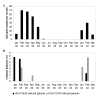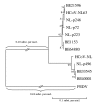A novel pancoronavirus RT-PCR assay: frequent detection of human coronavirus NL63 in children hospitalized with respiratory tract infections in Belgium
- PMID: 15686594
- PMCID: PMC549190
- DOI: 10.1186/1471-2334-5-6
A novel pancoronavirus RT-PCR assay: frequent detection of human coronavirus NL63 in children hospitalized with respiratory tract infections in Belgium
Abstract
Background: Four human coronaviruses are currently known to infect the respiratory tract: human coronaviruses OC43 (HCoV-OC43) and 229E (HCoV-229E), SARS associated coronavirus (SARS-CoV) and the recently identified human coronavirus NL63 (HCoV-NL63). In this study we explored the incidence of HCoV-NL63 infection in children diagnosed with respiratory tract infections in Belgium.
Methods: Samples from children hospitalized with respiratory diseases during the winter seasons of 2003 and 2004 were evaluated for the presence of HCoV-NL63 using a optimized pancoronavirus RT-PCR assay.
Results: Seven HCoV-NL63 positive samples were identified, six were collected during January/February 2003 and one at the end of February 2004.
Conclusions: Our results support the notation that HCoV-NL63 can cause serious respiratory symptoms in children. Sequence analysis of the S gene showed that our isolates could be classified into two subtypes corresponding to the two prototype HCoV-NL63 sequences isolated in The Netherlands in 1988 and 2003, indicating that these two subtypes may currently be cocirculating.
Figures





References
-
- Cavanagh D. Nidovirales: a new order comprising Coronaviridae and Arteriviridae. Arch Virol. 1997;142:629–633. - PubMed
-
- Lai MMC, Holmes KV. Coronaviridae: the viruses and their replication. In: Knipe DM, Howley PM, editor. Fields Virology. 4. Lippincott Williams & Wilkins; Philadelphia; 2001. pp. 1163–1185.
-
- Hamre D, Procknow JJ. A new virus isolated from the human respiratory tract. Proc Soc Exp Biol Med. 1966;121:190–193. - PubMed
Publication types
MeSH terms
Substances
Associated data
- Actions
- Actions
- Actions
- Actions
- Actions
- Actions
- Actions
- Actions
- Actions
- Actions
- Actions
- Actions
- Actions
- Actions
- Actions
- Actions
- Actions
- Actions
- Actions
- Actions
- Actions
- Actions
- Actions
- Actions
- Actions
- Actions
LinkOut - more resources
Full Text Sources
Other Literature Sources
Miscellaneous

